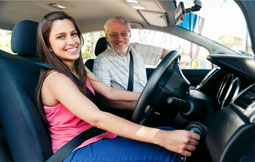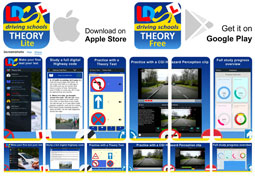How the course programme works
The driving lesson topics are grouped into three main categories depending upon which aspect of your driving skills they are primarily targeting.
- 1. Basic control skills lessons to learn how to control and manoeuvre the vehicle;
- 2. Road skills lessons to learn how to correctly deal with the various road features and systems that exist;
- 3. Traffic skills lessons to learn how to safely deal with other road users and difficult traffic situations.

Naturally, every lesson will to some degree incorporate the development of each of the three sets of skills above but the main focus will be on the one relevant to that part of the programme. A graph notionally depicting the development of each skill set across each part of the course is shown above.
Part 1 Basic control skills driving lessons
During the part 1 lessons you are looking to develop a certain sensitivity and precision in the way you co-ordinate your eyes, hands and feet to get the car to physically do what you want it to do. This will only be achieved by you directing your own body with feedback from your sensors on how it feels when you have got it right without unnecessary input from your instructor. By the end of part 1 your clutch control, gear changing, steering, signaling and observational checks should almost be automatic requiring little conscious effort. The less you involve your theoretical conscious mind the better. Instead rely on your instincts. You could call these your basic control skills.
After lesson 4 the reversing manoeuvre lessons can be introduced in the order shown to further develop your control skills. Each manoeuvre may form a lesson on its own or be part of another from the main programme.
Sometimes undertaking a manoeuvre can provide a useful change of activity within another lesson. These lessons do not rely upon component skills from any other lessons apart from the first four and as such form a kind of mini course almost separate from the main course.
Part 2 Road skills driving lessons
During the part 2 lessons you are learning how to apply your basic control skills to negotiate a variety of physical road features (i.e. bends, junctions, roundabouts and pedestrian crossings). This involves the need to co-ordinate previously learned control skills in different ways depending upon the road feature being encountered and the prescribed procedure for dealing with them as stated in the Highway Code. You could call these road skills or procedural skills (i.e. applying the rules of the road).
Some road features are more difficult to negotiate than others and therefore appear in later rather than earlier lessons. Some features may be physically easier to negotiate but because they are designed to manage large volumes of traffic or more vulnerable road users they are in fact more difficult to deal with due to the increase in risk.
Each road feature can be easier or more difficult to negotiate depending upon the following difficulty factors:
- The path you need to take around the feature (e.g. going left, right, straight on).
- What you can see on approach or as you negotiate the feature.
- The physical characteristics of the road feature (e.g. layout, width of road, height of kerb, the camber, shape of turn or bend, gradient of road etc.).
- The number of parked vehicles or other obstructions.
- Parking, waiting or other road restrictions.
- The volume and speed of traffic likely to be encountered.
- The likely presence of vulnerable road users or pedestrians.
- The time of day or day of the week.
- The weather.
- What combination of skills you will need to apply, in what order, how quickly and how accurately.
Naturally you try to start with the easiest version of the road feature you are learning to negotiate and gradually progress on to the more difficult ones (i.e. building in small easy steps). These lessons will also involve you in the development of basic traffic skills as the difficulty increases due to the last 4 factors above.
Part 3 Traffic skills driving lessons
During the part 3 lessons observation, anticipation, risk assessment, control, accuracy, planning and judgement skills become far more critical as you deal with higher speeds and increased volumes of traffic and/or other road users. You could call these traffic skills or thinking/decision making skills.
The first lesson in part 3 aims to make sure the key thinking skills are in place before dealing with some of the most hazardous aspects of driving, namely dual carriageways, busy town/city centres and driving on national speed limit roads. Once you have established sufficient awareness of the potential hazards and risks involved you will better appreciate the need to adopt a defensive driving style and if saving money or the planet is important to you, the need to adopt an eco-safe driving approach.
The way you develop your skills at this stage is very similar to the roads skills but with more emphasis on those road features that require a good set of thinking skills to be in place.











